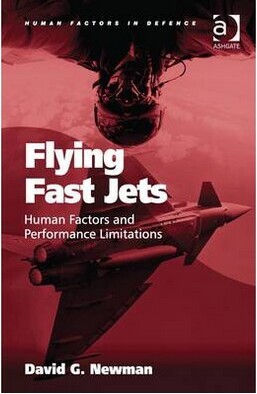
Flying Fast Jets: Human Factors and Performance Limitations
[Book Description]
This book provides a detailed general overview of the human factors and performance limitations associated with flying fast jets, integrating all the latest available research literature on the demanding operational tasks faced by such pilots and aircrews. As such, it has a strong military focus, dealing with pilots of fighter aircraft, attack aircraft and lead-in fighter trainer aircraft that are traditionally only single or dual pilot operations. The book deals not only with the issue of G force, but discusses ejection and escape/survival, disorientation, high altitude physiology, pilot training and selection, helmet-mounted equipment, situational awareness, data fusion and multi-sensor integration, human machine interface issues and advanced cockpit design. It examines the human performance issues associated with the technological advances made in fast jets, such as increased manoeuvrability, increased use of the pilot's head as a mounting platform for sensor and weapons systems, and the complexities involved in the human-machine interface within these aircraft.
[Table of Contents]
List of Figures ix
Abbreviations xi
Foreword xv
Preface xvii
Acknowledgements xix
1 The Fast Jet Environment 1 (16)
Fighter Operations 1 (11)
Definition of a Fighter Aircraft 1 (1)
Fighter Aircraft Generations 2 (1)
Weapons Systems 3 (1)
Guidance system 4 (2)
Warhead 6 (1)
Propulsion system 6 (1)
Fighter Tactics 6 (5)
Fighter Missions 11 (1)
Fighter sweep 11 (1)
Point defence 11 (1)
Strike escort 12 (1)
Intercepts 12 (1)
Attack Aircraft Operations 12 (4)
Definition of an Attack Aircraft 12 (1)
Weapons Systems 13 (1)
Attack Missions 14 (1)
Attack Aircraft Tactics 15 (1)
Super-Agile Flight 16 (1)
2 Altitude 17 (16)
Atmospheric Physics 17 (1)
Low Pressure 18 (2)
Hypoxia 20 (5)
Incidence 21 (1)
Signs and Symptoms 22 (2)
Tolerance to Hypoxia 24 (1)
Time of Useful Consciousness 25 (1)
Training 25 (1)
Cockpit Pressurisation 25 (3)
The Fast Jet Pressurisation System 26 (1)
Cockpit Pressurisation Failure 27 (1)
The Oxygen System 28 (2)
Other Altitude Problems 30 (1)
Decompression Illness 30 (1)
Ebullism 31 (1)
Case Study 31 (2)
3 Acceleration 33 (16)
The Physics of G 33 (3)
Magnitude of G 34 (1)
Direction of G 34 (2)
Physiological Effects of G 36 (5)
Visual Effects of 37 (1)
A-LOC 38 (1)
G-LOC 38 (2)
Prevalence of G-LOC 40 (1)
Clinical G Problems 41 (2)
Induced Neck Injuries 41 (1)
Respiratory Effects 41 (1)
Miscellaneous G Effects 42 (1)
G Tolerance 43 (1)
G Protection Measures 44 (3)
G-Suits 44 (1)
Anti-G Straining Manoeuvre 45 (1)
Positive Pressure Breathing 46 (1)
Centrifuge Training 47 (1)
A Glimpse into the High G Future 47 (1)
Case Study 48 (1)
4 Spatial Disorientation 49 (16)
Definitions 49 (1)
Type I (Unrecognised) 49 (1)
Type II (Recognised) 50 (1)
Type III (Incapacitating) 50 (1)
Prevalence of Spatial Disorientation 50 (1)
Underlying Mechanisms 51 (3)
Illusions by Phase of Flight 54 (5)
Take-off 54 (1)
In-flight Phase 55 (3)
Landing 58 (1)
Risk Factors 59 (2)
Pilot Factors 59 (1)
Aircraft Factors 60 (1)
Operational Factors 61 (1)
Countermeasures 61 (2)
Training 61 (1)
Technology 62 (1)
Case Study 63 (2)
5 Life Support Equipment 65 (16)
The Flight Suit 65 (1)
The Flight Helmet 66 (5)
Impact Protection 68 (1)
Helmet-Mounted Sighting and Display 69 (1)
Systems
Advanced Helmet Design Options 70 (1)
The Oxygen Mask 71 (1)
The G-Suit 72 (1)
Chest Counterpressure Garment 73 (1)
The Survival Vest 74 (1)
The Immersion Suit 74 (1)
The Liquid Cooling Garment 75 (1)
The CBRN Ensemble 76 (1)
Anthropometry 77 (1)
Aircrew Equipment Integration 78 (3)
6 Situational Awareness 81 (16)
Defining Situational Awareness 81 (2)
The Fast Jet Cockpit 83 (3)
Sensor Systems 86 (3)
Aircraft Performance Sensors 86 (1)
Tactical Situation Sensors 86 (1)
Radar 87 (1)
Infra-red search and track 88 (1)
Targeting FLIR 88 (1)
Threat detection 89 (1)
Displays 89 (6)
Head-Up Displays 89 (2)
Helmet-Mounted Display and Sighting 91 (1)
Systems
Joint Helmet-Mounted Cueing System 92 (1)
(JHMCS)
Night Vision Goggles 92 (2)
Challenges and Limitations 94 (1)
Sensor Fusion 95 (2)
7 Escape 97 (18)
History of Escape from Aircraft 97 (2)
The Modern Ejection Seat 99 (2)
Anatomy 99 (1)
Performance Specifications 100 (1)
Typical Ejection Sequence 101 (2)
Ejection Posture 103 (1)
Survival Outcomes 103 (3)
Ejection Injuries 106 (4)
The Catapult Phase 106 (2)
The Aircraft Separation Phase 108 (1)
The In-Seat Flight Phase 109 (1)
The Parachute Descent Phase 109 (1)
The Landing Phase 109 (1)
Post-Ejection Considerations 110 (1)
Next-Generation Seats 111 (1)
Case Study 112 (3)
8 Selection and Training 115 (16)
Selecting the Fast Jet Pilot 115 (3)
Review of Selection Methodologies 116 (2)
Training the Fast Jet Pilot 118 (13)
Fast Jet Flight Training 118 (3)
Use of Flight Simulators 121 (1)
Human Factors Training 122 (2)
Ejection seat training 124 (1)
Spatial disorientation training 124 (1)
Hypoxia training 125 (2)
Centrifuge training 127 (2)
NVG training 129 (2)
References 131 (16)
Index 147

 新书报道
新书报道